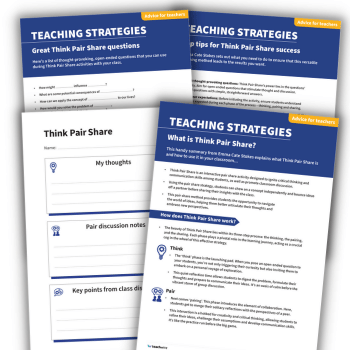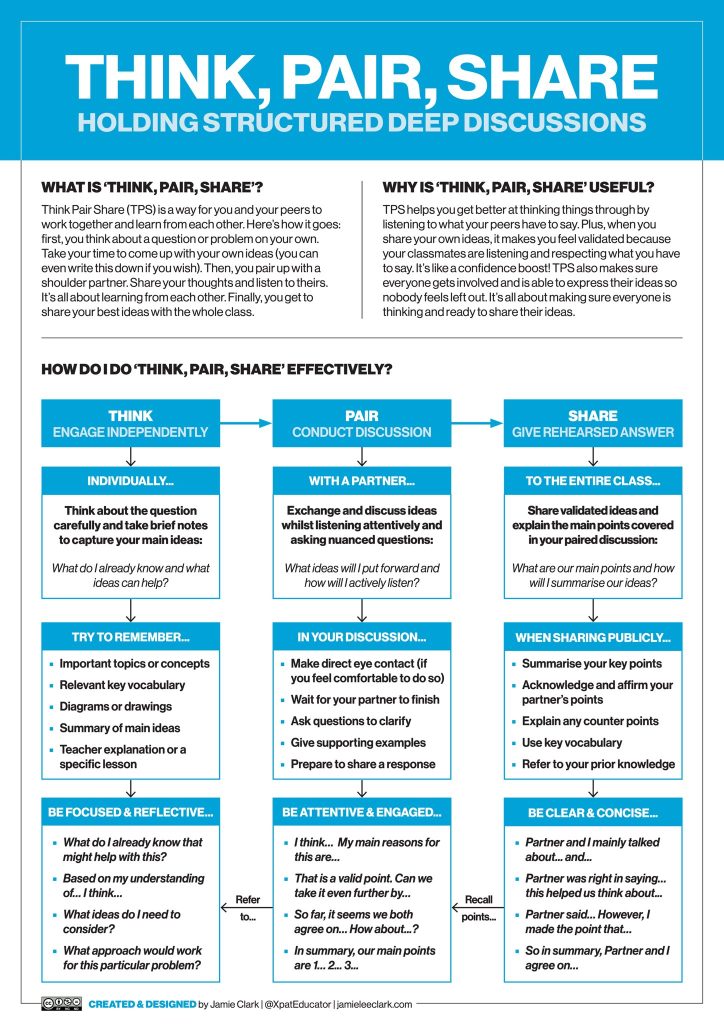Think Pair Share – How to unleash its power in your classroom

How to use the Think Pair Share strategy in your classroom to boost classroom engagement, foster open communication and more…

- by Emma Cate Stokes
- Writer, former teacher and co-founder of EdTech Innovation Hub Visit website

Picture this: it’s Monday morning, your coffee is still steaming, and the buzz of excitement is palpable in your classroom. The plan is to start things with a simple yet powerful technique – the Think Pair Share strategy.
It’s a surprisingly effective cooperative learning tool that can create an environment rich with engaged minds and bubbling conversations. If you’re unfamiliar with the approach or need a refresher, you’re in the right place.
Let’s delve into the world of the ‘Think Pair Share’ strategy and why it deserves a place in your teaching toolbox.

What is Think Pair Share?
Think Pair Share isn’t just another educational buzzword. It’s an interactive pair share activity designed to ignite critical thinking and communication skills among students, as well as promote classroom discussion.
“Think Pair Share isn’t just another educational buzzword”
Using the pair share strategy, students can chew on a concept independently and bounce ideas off a partner before sharing their insights with the class.
This pair share method provides students the opportunity to navigate the world of ideas, helping them better articulate their thoughts and embrace new perspectives.
How does Think Pair Share work?
The beauty of this strategy lies within its three-step process: the thinking, the pairing, and the sharing. Each phase plays a pivotal role in the learning journey, acting as a crucial cog in the wheel of this effective strategy.
Example of Think Pair Share activity
Think
The ‘think’ phase is the launching pad. When you pose an open-ended question to your students, you’re not only triggering their curiosity but also inviting them to embark on a personal voyage of exploration.
This quiet reflection time allows students to digest the problem, formulate their thoughts and prepare to communicate their ideas. It’s an oasis of calm before the vibrant storm of group discussion.
Pair
Next comes ‘pairing’. This phase introduces the element of collaboration. Here, students get to merge their solitary reflections with the perspectives of a peer.
This interaction is a hotbed for creativity and critical thinking, allowing students to refine their ideas, challenge their assumptions and develop communication skills. It’s like the practice run before the big game.
Share
Finally, the ‘sharing’ phase – the grand finale. This is where the classroom transforms into a buzzing hive of insights, a marketplace for ideas.
In this stage, students present their thoughts to the larger group, broadening the discussion and inviting constructive feedback. This open exchange boosts students’ confidence and fortifies the sense of community within the class.
Is Think Pair Share a formative assessment?
It can be! Think Pair Share doubles as a handy formative assessment tool. As students engage in their pair share activity, you can navigate the classroom, listening in on discussions, identifying misconceptions and assessing comprehension. All the while you’re also looking for those giving the correct answer.
This real-time feedback is a treasure trove of information to shape future lessons and provide targeted instruction. It’s a window into a student’s mind, giving you insights that go beyond a correct answer.
“This real-time feedback is a treasure trove of information”
Why use this strategy?
Now you may wonder, “Why should I use Think Pair Share?”. Well, there’s plenty of perks. It’s an inclusive strategy that ensures every student, even the more introverted ones, can share their thoughts and develop language skills.
Benefits of Think Pair Share
Think Pair Share strengthens class discussion and cohesion, encouraging students to share ideas and develop critical social skills.
“It’s an inclusive strategy that ensures every student”
By pushing students to discuss and share ideas, you’re fostering an environment that bolsters creativity and critical thinking.
These small group interactions can often generate solutions that a solo effort might not. Not to mention, it instils in students the confidence to voice their thoughts in open discussions, a skill invaluable inside and outside the classroom.
How to do Think Pair Share effectively
- Craft thought-provoking questions: Think Pair Share’s power lies in the questions’ quality. Aim for open-ended questions that stimulate thought and discussion. Avoid questions with simple, straightforward answers.
- Set clear expectations: Before initiating the activity, ensure students understand what is expected during each phase of the process – thinking, pairing and sharing.
- Encourage active listening: Remind students that a big part of the pair share activity involves listening. Active listening can foster respect and understanding during discussions.
- Monitor and guide: During the pair share activity, walk around the classroom, listen to conversations and guide where needed. This helps keep discussions on track and provides valuable insight into student understanding.
- Foster a safe environment: Encourage openness and respect for differing viewpoints. This will make students feel more comfortable in sharing their thoughts.
- Inclusion is key: Make sure every student, regardless of their usual participation level, gets a chance to share their ideas with the class. If there are time limitations, this can only be through sharing the answer directly with the class. It may be a thumbs up or down if the class agrees with the point the speaker is making.
- Mix it up: Keep the strategy fresh and engaging by varying the pairs and small groups.
- Reflect and refine: Take a few moments to reflect on what worked well and what didn’t. This will help you refine the strategy for future use.
Why is it effective?
Remember, the success of the Think Pair Share strategy lies in its flexibility. Feel free to adapt it according to your students’ needs and the lesson’s learning goals.
It’s all about creating an engaging and collaborative learning environment that encourages students to think deeply, communicate effectively and learn from each other.
The effectiveness of this learning strategy lies in its simplicity and adaptability. It creates the opportunity for students to offer their perspectives and fosters a vibrant learning community.
“The effectiveness of this learning strategy lies in its simplicity and adaptability”
Each stage allows students to reflect, articulate, listen, and engage, honing their cognitive and language skills within one activity.
The Think Pair Share strategy is an ally for any teacher hoping to encourage active participation and develop essential social skills among their students.
It champions the power of collaborative learning, inviting students to engage with the material in a dynamic and meaningful way. By sparking rich discussions, Think Pair Share creates a fertile ground for the growth of new ideas, encouraging students to learn from the teacher and each other.
Give Think Pair Share a whirl if you’ve been hunting for a tried-and-true technique to boost classroom engagement, conduct quick formative assessments, foster open communication, and create a thriving learning community.
It’s like a breath of fresh air for your classroom discussions, and who knows? It may become your new favourite teaching strategy.
Emma Cate Stokes is a freelance writer and former primary teacher. Download our think pair share PDF, featuring a pupil worksheet and CPD resources.







